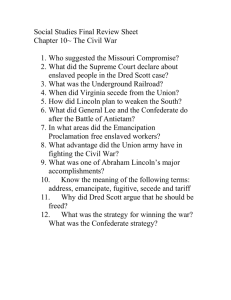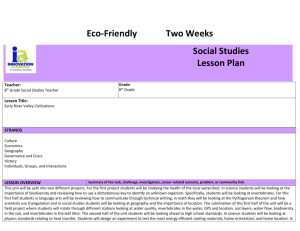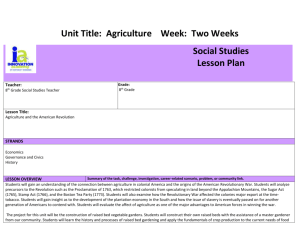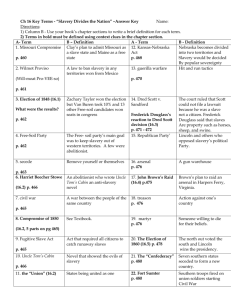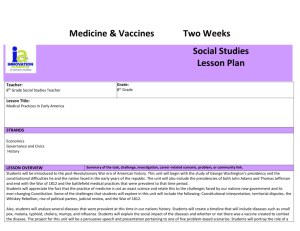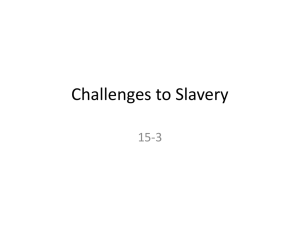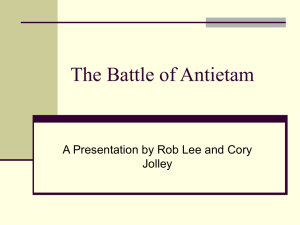8th Social Studies Space Exploration
advertisement
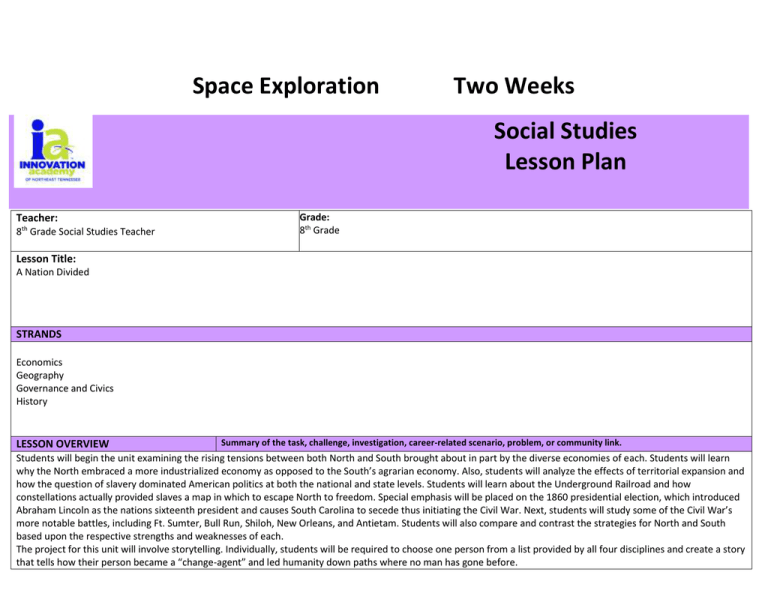
Space Exploration Two Weeks Social Studies Lesson Plan Teacher: th 8 Grade Social Studies Teacher Grade: 8th Grade Lesson Title: A Nation Divided STRANDS Economics Geography Governance and Civics History LESSON OVERVIEW Summary of the task, challenge, investigation, career-related scenario, problem, or community link. Students will begin the unit examining the rising tensions between both North and South brought about in part by the diverse economies of each. Students will learn why the North embraced a more industrialized economy as opposed to the South’s agrarian economy. Also, students will analyze the effects of territorial expansion and how the question of slavery dominated American politics at both the national and state levels. Students will learn about the Underground Railroad and how constellations actually provided slaves a map in which to escape North to freedom. Special emphasis will be placed on the 1860 presidential election, which introduced Abraham Lincoln as the nations sixteenth president and causes South Carolina to secede thus initiating the Civil War. Next, students will study some of the Civil War’s more notable battles, including Ft. Sumter, Bull Run, Shiloh, New Orleans, and Antietam. Students will also compare and contrast the strategies for North and South based upon the respective strengths and weaknesses of each. The project for this unit will involve storytelling. Individually, students will be required to choose one person from a list provided by all four disciplines and create a story that tells how their person became a “change-agent” and led humanity down paths where no man has gone before. Hook for the week unit or supplemental resources used throughout the week. (PBL scenarios, video clips, websites, literature) MOTIVATOR Day 1: Civil War Intro. This video clip explains some of the background information leading up to the Civil War. It begins by describing how the economies of both the North and the South evolve over the time period of the Industrial Revolution allowing the North to concentrate more on factory based means of production while the South capitalizes on the invention of the cotton gin, thus increasing its overall demand for slave labor. It explains how the question of slavery eventually polarizes both North and South and helps to rip the nation apart leading America into its bloodiest war ever fought. DAY Objectives (I can….) 1 I can summarize the effects of territorial expansion on the debate over slavery. I can analyze how the Compromise of 1850 fueled the Union’s crisis. Materials & Resources I-Pads, dry erase board Instructional Procedures Differentiated Instruction Essential Question: Remediation: What issues and events shattered the nation’s unity and pushed America to civil war? Abbreviated Assignment-Allow students to complete the time line beginning with Wilmot Proviso and ending with the Kansas-Nebraska Act. 1/2 Project Day – See Unit Plan Going Where No Man Has Gone Before- Introduction Set: Students will use their i-pads and come up with a list at their tables of people associated with the Civil War. Students may move about the room and look at any posters hanging in the classroom that might help, but will only have 45 seconds to do so. After the 45 seconds is up, students will go back to their tables and continue the list for an additional three minutes. Once time is called, call on tables to airplay their results and discuss. Enrichment: Brainstorm issues that divide the United States today. Students will write a speech Assessment Formative Assessment: Students will choose both I can statements and write a paragraph on each. Teaching Strategy(s): 1. Students will view a brief PowerPoint presentation on the Wilmot Proviso, Compromise of 1850, Fugitive Slave Act, Harriet Beecher Stowe, and the Kansas-Nebraska Act. 2. Students will create a timeline of events. Students will begin with the 1846 war with Mexico and end with the formation of the Confederate States of America in 1861. 3. Students will be certain to include explanations of each of the following events: Wilmot Proviso, Compromise of 1850, Fugitive Slave Act, publishing of Uncle Tom’s Cabin, Kansas-Nebraska Act and effects, 1857 Dred Scott ruling, 1860 presidential election, and South Carolina’s secession in 1861. to Congress, offering a compromise solution to one such issue of their choice. Ask volunteers to present their speeches to class. Summarizing Strategy: Students will create a Compare/Contrast chart using their i-pads. Using the chart, students will answer the following question: How did the Northern response to the publication of Uncle Tom’s Cabin compare among white Southerners? 2 I can explain how the issue of slavery brought the nation to crisis. I can summarize the Supreme Court’s decision in the Dred Scott v. Sandford I-Pad, The Dred Scott case summary with questions. (Appendix A) Essential Question: Remediation: Why did the Dred Scott decision anger free-soilers and abolitionists? Students may choose either a Southerner or abolitionist point of view and write one editorial instead of two. Set: Dred Scott Clip This video clip introduces students to the Dred Scott decision of 1857, which is in effect the last true effort at abolishing slavery and perhaps avoiding a civil war. Chief Justice Taney and the court hands down its historic ruling and deepens the divide between both North and South and paves the way for the American Civil War. Teaching Strategy(s): 1. Students will open up the Dred Scott case summary and questions (Appendix A) on their i-pads. 2. Students will view a brief PowerPoint presentation about the Dred Scott case of 1857 and discuss the Supreme Court’s justification for ruling Enrichment: Students will create a political cartoon depicting the Dred Scott decision. Students will also research Formative Assessment: Students will be asked if they could answer today’s I can statements by showing thumbs up or thumbs down. against Dred Scott. case. (1857) Summarizing Strategy: Students will write two editorials in response to the Dred Scott decision; one from a pro-slavery Southern perspective, the other from an anti-slavery or abolitionist Northern perspective. Students should title their editorials with headlines phrased similar to how newspaper articles are titled. 3 I can explain the events that led up to the first shots fired at Fort Sumter. I can summarize the significance of the Battle of Bull Run for both the North and South. I-Pads, Apple TV, The Union Blockade Discussion Questions (Appendix B), Blockade Documents. (Appendix C) recent Supreme Court cases that have been depicted in political cartoons and share in small groups. Essential Question: Remediation: What were the strategies for both North and South to win the war? Students may write one paragraph on one of the strengths of either the Union army or the Confederate Army. Set: Fort Sumter 1861 Students will view a brief video explaining the first shots fired, thus beginning the Civil War. Students will learn about the people involved and the ironic fact that no person was killed or wounded in what was about to become America’s deadliest war ever fought. Teaching Strategy(s): 1. Students will view a PowerPoint presentation on the siege of Fort Sumter, the Confederate States of America, Strategies for both North and South, and the Battle of Bull Run (1861). 2. Students will use their i-pads and access the Union Blockade questions (Appendix B) and the Blockade Documents (Appendix C). Students will read and analyze the documents then answer the discussion questions. 3. Students will be asked randomly to airplay answers to the questions Enrichment: Students will draw a sketch map of the Anaconda Plan. Students should write brief annotations that summarize each point on the map. Formative Assessment: Students will answer both of today’s I can statements on an index card before exiting the classroom. and class discussion will follow. Summarizing Strategy: Students will create a graphic organizer using their i-pads that displays the strategies for both North and South. Students will write a letter from either a Confederate soldiers point of view or a Union soldiers point of view describing the advantage or disadvantage the other side has and how they think it will affect the overall outcome of the Civil War. 4 Project Day – See Unit Plan Going Where No Man has Gone Before – Learning from a STEM Professional 5 Project Day – See Unit Plan Going Where No Man has Gone Before – Research Day 6 I can explain why so many volunteers signed up to fight in the Civil War. I can describe the correlation between advanced Civil War weaponry and the high number of casualties. I-Pads, dry erase board, Apple TV, Mac Books. Essential Question: Remediation: Formative: How did the Civil War differ from previous American conflicts? Students will be paired heterogeneously in their groups. Students will answer both I can statements as an exit-ticket before leaving class. Set: Civil War Technology Students will view a short clip describing some of the new weapons of warfare first utilized during the Civil War. The video clip includes information on the new rifles, the ironclad warships, railroads, and battlefield tactics. Students will also examine some of the reasons why someone would volunteer to fight for either the North or South during the Civil War. Teaching Strategy(s): 1. Students will be placed in groups of two and given a specific technological advancement: repeating rifles, ironclad ships, telegraph, railroads, mini-ball, steam ships, hot-air balloons, grenades, and Ager or “coffee mill guns”. 2. Students will create a Prezi or PowerPoint presentation describing the new technology, explaining how it affected the way the war was fought and summarizing its impact on military strategy. 3. Students will also create a diagram of their new technology showing how their new weapon of warfare worked. Summarizing Strategy: Students will create a pamphlet that illustrates both the pros and cons of the new technology and explains the various ways in which the new technology changed how war was fought. Each pamphlet will also include the estimated number of casualties that their weapon was responsible for during the Civil War. Enrichment: Allow students to research the casualty figures of the Civil War and create a graph to display their findings. Students may also wish to create a graph showing the casualties of some of the more famous battles of the Civil War. 7 I can explain why Ulysses S. Grant became popular with President Lincoln as his choice of command of all Union troops. I can explain why General Lee decided to invade the North at the Battle of Antietam. I-Pads, Apple TV, Proclamation to the People of Maryland document. (Appendix D) Special Order #191 document. (Appendix E) Battle of Antietam map (Appendix F). Essential Question: Remediation: In 1862, how close did the South come to winning the Civil War? Students may create a newspaper article in place of a written letter. Students should have an attentiongrabbing headline and a summary of the Battle of Antietam. Set: Antietam Clip Students will view a video clip describing the bloodiest battle of the entire Civil War…Antietam. The video clip informs the viewers who the major generals were at Antietam and explains the interesting fact that General Lee makes a terrible military blunder-losing four days worth of battle plans. General McClellan is able to capitalize by finding Lee’s plans and initiate the famous Battle of Antietam. Teaching Strategy: 1. Students will view a brief PowerPoint presentation on the battles of Shiloh, New Orleans, and Antietam. 2. Students will analyze General Lee’s Proclamation to the People of Maryland (Appendix D). A class discussion will revolve around the reasons why Lee decides to invade then and why he chooses the state of Maryland. 3. Students will then analyze Lee’s Special Order #191. Students will come up with their own battle plan against Lee’s army as if Special Order #191 had never been found. Students will use the map of the Battle of Antietam (Appendix F). Summarizing Strategy: Students will write a letter to President Jefferson Davis outlining their reasons for supporting or not supporting Lee’s decision to invade the North and whether or not they believe the Confederacy is winning the war at present. Enrichment: Divide students into groups. One group will prepare arguments supporting the idea that the Union is closer to victory and the other group will prepare arguments that the Formative Assessment: Students will answer today’s I can statements on an index card before leaving class. Confederacy is closer to victory. 8 Project Day – See Unit Plan Going Where No Man has Gone Before – Finalize Story 9 Project Day – See Unit Plan Going Where No Man has Gone Before – Peer and Teacher Review 10 Project Day – See Unit Plan Going Where No Man has Gone Before – Storytelling Festival STANDARDS Identify what you want to teach. Reference State, Common Core, ACT College Readiness Standards and/or State Competencies. GLE 8.2.01 Understand fundamental economic concepts and their application to a variety of economic systems. GLE 8.2.02 Understand global economic connections, conflicts, and interdependence. GLE 8.2.03 Understand the potential costs and benefits of individual economic choices in the market economy. GLE 8.2.04 Understand the interactions of individuals, businesses, and the government in a market economy. GLE 8.3.03 Recognize the interaction between human and physical systems. GLE 8.3.04 Understand the geographic factors that determined the locations and patterns of settlements in the United States and Tennessee. GLE 8.4.01 Appreciate the development of people's need to organize them into a system of governance. GLE 8.4.02 Recognize the purposes and structure of governments. GLE 8.4.03 Understand the relationship between a place's physical, political, and cultural characteristics and the type of government that emerges from that relationship. GLE 8.4.04 Discuss how cooperation and conflict among people influence the division and control of resources, rights, and privileges. GLE 8.4.05 Understand the rights, responsibilities, and privileges of citizens living in a democratic society. GLE 8.4.06 Understand the role the Constitution of the United States plays in the lives of Americans. GLE 8.4.07 Understand the role that Tennessee's government plays in Tennessean’s lives. GLE 8.5.15 Discuss sectional differences brought on by the Western movement, expansion of slavery, and emerging industrialization. GLE 8.5.18 Recognize the causes, course, and consequences of the Civil War. SPI 8.2.9. Analyze in economic terms, (i.e., climate, triangle trade, infrastructure, topography), why slavery flourished in the South as opposed to the North. SPI 8.3.1. Recognize the causes and examples of migration and immigration in early America (i.e., land, religion, money, pioneer spirit, indentured servitude, displacement, and slavery). SPI 8.4.3. Recognize the purpose of government and how its powers are acquired, used, and justified. SPI 8.4.4. Recognize the rights and responsibilities of individuals throughout the development of the United States. SPI 8.4.5. Identify how conditions, actions, and motivations contributed to conflict and cooperation between states, regions and nations. SPI 8.4.7. Recognize the impact of major court decisions have had on American life, (i.e., Marbury v Madison, McCulloch v. Maryland, Dred Scott v. Sandford). SPI 8.5.5. Recognize consequences of the westward expansion of the United States. SPI 8.5.6. Classify the characteristics of major historic events into causes and effects (i.e., exploration, colonization, revolution, expansion, and Civil War). SPI 8.5.8. Determine the social, political, and economic factors that contribute to the institution of slavery in America. SPI 8.5.9. Interpret a timeline, detailing the development of political parties in the United States to the Civil War. SPI 8.5.10. Interpret maps, time lines and charts that illustrate key elements of history (i.e., expansion, economics, politics, society). SPI 8.5.11. Identify conclusions about historical events using primary and secondary sources. SPI 8.5.12. Differentiate between primary and secondary source documents. SPI 8.5.13. Examine the demographic changes brought about by westward movement (i.e., slavery, industrialization, and Native American relocation).
